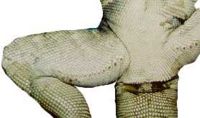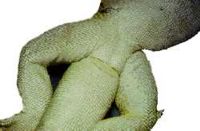Lizard Reproductive System
| This article has been peer reviewed but is awaiting expert review. If you would like to help with this, please see more information about expert reviewing. |
Male
Male lizards have paired hemipenes that are sac-like and lack erectile tissue. They are stored, inverted, in the base of the tail and may produce bulges in the ventral proximal tail. Only one is used at a time during copulation and it is not involved in urination. The testicles increase in size during the breeding season.
A row of femoral pores can be seen on the medial aspect of the thigh in many families of lizard. The waxy secretion of cellular debris produced is thought by some to have territorial scent marking significance and by others to prevent the male sliding on the belly of the female during coitus (see also preanal pore).
Mature adult male iguanas have taller dorsal spines than females, as well as larger dewlaps and operculum scales. Elaborate head ornamentation (horns, crests and plates) can be seen in adult male chameleons but not in females. Generally, for most lizard species, males are larger than their female counterparts or have larger heads, bigger crests, brighter colours, or erectable dewlaps.
- For information on Hemipenal abscesses, see Lizard Hemipenal Abscesses.
Female
Females have paired ovaries and oviducts, which enter into the urodeum of the cloaca. The oviduct is divided into four regions: infundibulum; magnus (secretes albumin); uterus (secretes membrane); and vagina. Dystocia is common and may be pre-ovulatory or post-ovulatory. Fertilization is internal.
For information on lizard sexing, see Lizard Physical Examination.
For information on lizard dystocia, see Lizard and Snake Dystocia.
References
- Mader, D.R. (2005). Reptile Medicine and Surgery. Saunders. pp. 1264. ISBN 072169327X

